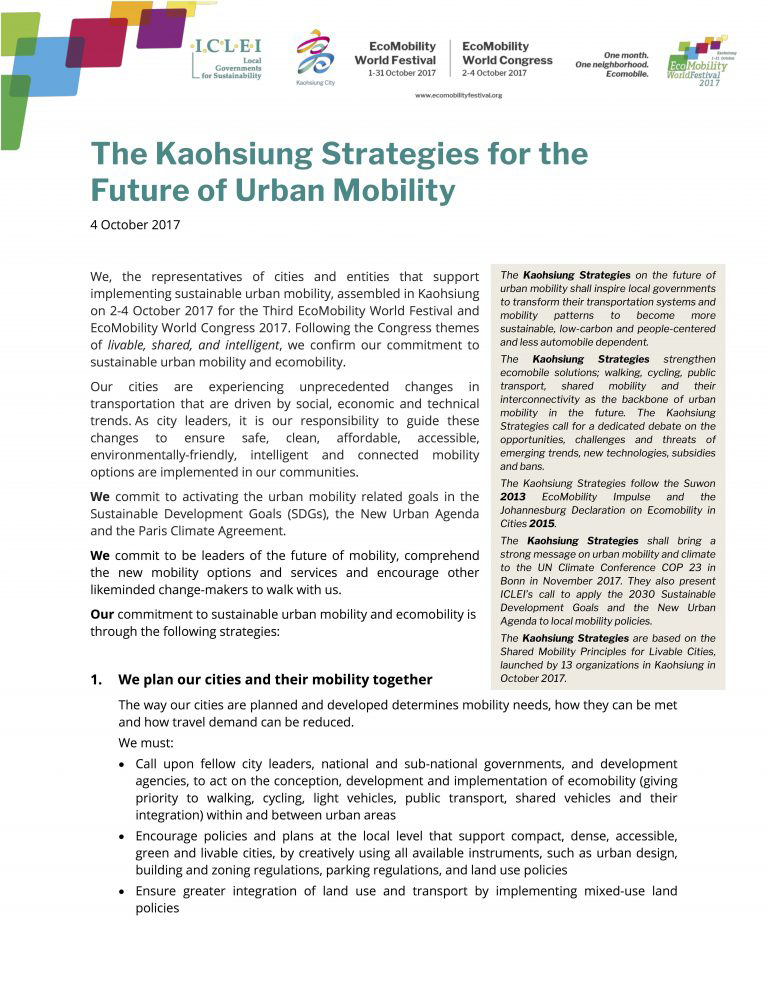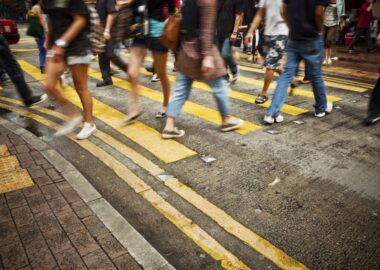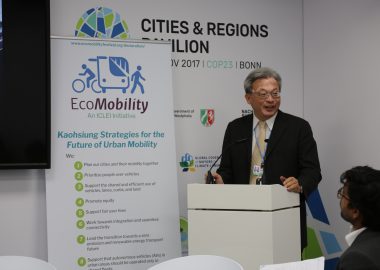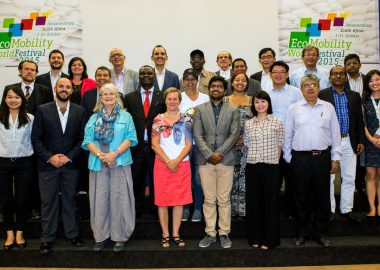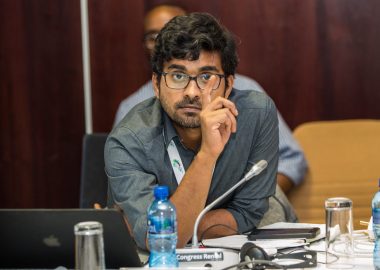Kaohsiung Strategies
12 Strategies
Call upon fellow city leaders, national and sub-national governments, and development agencies, to act on the conception, development and implementation of ecomobility (giving priority to walking, cycling, light vehicles, public transport, shared vehicles and their integration) within and between urban areas.
Encourage policies and plans at the local level that support compact, dense, accessible, green and livable cities, by creatively using all available instruments, such as urban design, building and zoning regulations, parking regulations, and land use policies.
Ensure greater integration of land use and transport by implementing mixed-use land policies.
Be ambitious when preparing and implementing sustainable urban mobility plans with short term and long-term goals, decisions and investments.
Advantage those mobility modes that serve the majority of the people and disadvantage infrastructure for personal automobiles.
Consider moving people and goods instead of moving vehicles.
Invest in multi-modal infrastructure that increases accessibility especially for pedestrians, cyclists and public transport and reduces the use of single occupant personal vehicles.
Encourage a car-free lifestyle and discourage the desire and the need for private automobile ownership.
Plan for a maximum of 150 cars per 1000 inhabitants, mainly as shared cars.
Aim for a modal split where personal automobiles always represent a smaller share than other ecomobile options (walking, cycling, public transport and shared mobility).
Ensure safe roads for people by setting an overall urban area speed limit of 30 km/h and 20 km/h in residential areas.
Use traffic calming strategies to slow vehicles.
Ensure investment in active transport (walking, cycling etc.) amount to at least 10 percent of road investment.
Encourage small, light and right-sized vehicles with reduced energy and resource consumption and discourage the use of oversized vehicles, such as SUVs, by introducing size- and weight-based registration fees and access restrictions to inner city areas.
Plan for and invest in new approaches to accommodate the emerging variety of light, small, human powered and electric vehicles with different speeds for sharing road space between different modes and speeds. Experiment with complete and multi-purpose streets and explore opportunities of segregating modes.
Shift from minimum to maximum parking requirements (standards) for commercial and residential developments.
Price on-street parking higher than off-street parking.
Give dedicated space and signal prioritization to public transport and make their travel times more attractive than the one for vehicles.
Increase the acceptable level of congestion to avoid public investment in new roads.
Reduce travel demand by creatively designing public spaces that offer informal shopping, eateries, farmers markets within easy walking and cycling distance to residential areas.
In particular, take children seriously; they are indicators of our cities’ and societies’ health and social exclusion starts in childhood.
Ensure physical, digital, and financial access to public space and transportation facilities for people of all ages, gender, income levels, and physical and mental abilities.
Ensure that every vehicle and mode should pay their fair share for road use, congestion, pollution, and use of curb space. The fair share shall take the design, construction, operating, maintenance and social costs into account.
Create disincentives for motorized private vehicles such as levying high fuel taxes, adding road tolls, and increasing parking pricing and allocating investment gained towards active transport and public transport infrastructure.
Terminate subsidies for non-sustainable mobility options.
Establish road use charges for vehicles based on miles traveled or vehicle weight. These charges can then fund design, construction, operations, and maintenance of road facilities.
Employ congestion pricing for areas such as city centers to regulate peak period travel demand and fund design, construction, and operations, and maintenance of road facilities or contribute to covering the social and environmental costs of vehicles.
Integrate all transportation services and thoughtfully plan across service providers, geographies and complementary nodes.
Develop intermodal nodes that serve as focal points in the transportation network.
Facilitate multi-model trips by enhanced on-site and online transportation service information on connections, payments and access.
Enhance local and regional cooperation in planning, operations, maintenance and funding of transportation facilities to enable a unified system.
Enable a systems approach for competition and innovation of data infrastructure for shared transport services while ensuring privacy, security, and accountability.
Set priorities in decision making and investments towards low emission, soot-free and environmentally friendly vehicles and mobility.
Shift public transportation and shared use fleets to zero emission vehicles.
Remove diesel-fueled vehicles from our cities by 2025.
Ban fossil-fuel vehicles from cities by 2040 and stop all subsidies for these vehicles.
Remove fossil-fuel subsidies in our cities by 2030 and support the transition away from fossil fuel by rationalizing the inefficient fossil-fuel subsidies and set fuel taxes.
Promote small, lightweight, shared electric vehicles powered by renewable energy.
Work with the energy sector to enable an energy transition towards renewable energy as a condition for e-mobility.
Prioritize active mobility modes in all planning and decisions and the use of public transport over shared automated vehicles.
Build capacities among local decision makers and planners on the diverse aspects and impacts of autonomous driving and artificial intelligence for our cities.
Regulate the operation of autonomous vehicles with public interests and infrastructure in mind.
Protect public goods and interests and engage public and private decision makers in the debate and decision making.
Require that all autonomous vehicles are zero-emission and part of shared fleets.
Prevent fencing of public space as a consequence of the introduction of autonomous vehicles.
Ensure maximum public safety, and that maintenance and software upgrades are managed by professionals.
Protect the urban air space in our cities by applying sustainable principles to manage this public space and resource.
Require governments to regulate these vehicles and educate the public regarding the rules and regulations.
Limit the operation of drones and flying automobiles and taxis in urban areas to public security and public interest purposes and require permitting processes in participatory, transparent procedures.
Determine dedicated starting and landing spots and aerial traffic routes for permitted drone operations in "urban air traffic plans".
Introduce policies and rules for the movement of goods into transportation planning, and Sustainable Urban Mobility Plans.
Engage and support freight stakeholders in low-carbon freight solutions including truck sharing, route optimization, retiming freight delivery, more operational efficiency, higher fuel efficiency and alternative fuels, use of cargo bikes and electric mini-trucks for last-mile delivery and further innovative options.
Support localization of food and goods production to lower the long-distance transport of goods and to strengthen local economies.
Acknowledge the rights of street vendors, given they respect the sharing of public space and transport their goods in non-motorized or small and emission free vehicles.
Actively engage stakeholders in the decision-making process and take their interests into account.
Give priority to grass root organizations and neighborhood level solutions rather than to those being imported from distant locations with a different urban and social context.
Provide mechanisms for finding consensus or to balance conflicting interests.
Take into account that investments in stakeholder engagement for transportation related decisions often accelerates decision processes, identifies better solutions, fosters future cooperation, creates ownership and improves well-being of our urban life.
Encourage and request the creation of national urban mobility plans, the application of the subsidiarity principle, a constructive dialogue between national and local levels as well as enabling mechanisms to allow cities to manage, operate and finance their mobility.
Remain open to new technologies and change while prioritizing people and sustainability at the core of our decision making.
Educate local government staff so they may engage in and facilitate debates.
Request donors and funders as well as regional and national governments to provide resources for capacity building.
Engage in regional, national and international networks on sustainable transportation, learn from others and enrich the exchange through own innovation.
Develop Sustainable Urban Mobility Plans or equivalent transportation planning documents, with ambitious targets following the 2030 Sustainable Development Goals and the Paris Agreement on climate change and implement these policies and plans without delay.
Previous declarations
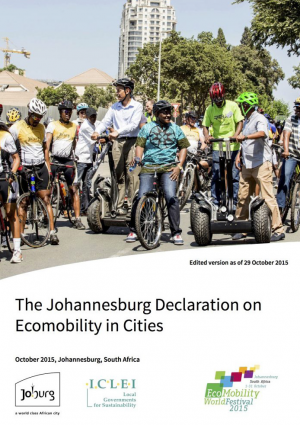
The Johannesburg Declaration on EcoMobility in Cities, 2015
The Johannesburg Declaration calls local, regional and national governments to commit to local actions that improve road safety, air quality, energy efficiency, and accessibility through ecomobility. It also highlights the importance of equitable and inclusive urban development, in line with the Sustainable Development Goals (SDGs).
Suwon 2013 EcoMobility Impulse
The purpose of the Suwon 2013 EcoMobility Impulse is to provide guiding thoughts, principles, examples and starting points for concrete improvements in urban planning & development, be it for existing municipalities or new towns, towards the greening of mobility in our cities worldwide.
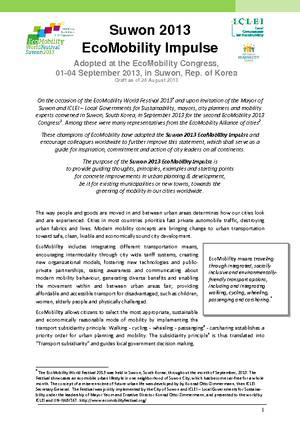
Related news

Published in December 2018
EcoMobility Alliance Report 2018
The EcoMobility Alliance seeks to encourage city-to-city knowledge exchange and drive local innovation, trusting that such activities will inspire local leaders to create an ecomobile transportation system that prioritizes walking, cycling, public transport, shared mobility and light electric vehicles.
This EcoMobility Alliance report 2018 showcases our progress so far and highlights the impressive achievements of the EcoMobility Alliance cities. All EcoMobility Alliance cities are interesting to study as they have all excelled in one way or another in creating a sustainable urban mobility system.

